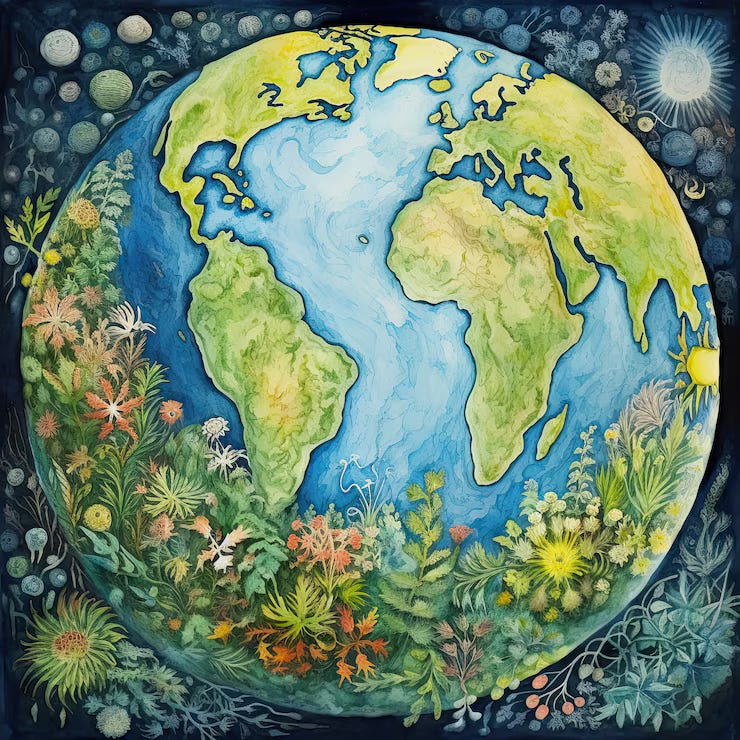I started this newsletter on Earth Day for obvious reasons, and that’s proven to be a good decision. Now when Earth Day rolls around, I really am forced to think about its meaning and my own efforts to bring a more life-centered perspective to the climate story. Is it having any effect? Is the narrative changing, shifting from a mechanical, carbon-only (emphasis on only) perspective to a living, whole-of-climate perspective?
I’m beginning to think so, slowly but surely. Perhaps the most encouraging thing I’ve noticed is the growing number of people talking about soils, water cycles and biodiversity, while steering themselves toward a more biocentric stance. A few events in particular stand out:
In July I came a across an article in resilience.org called Restoring Nature is Our Only Climate Solution. It was written by Richard Heinberg, a Senior Fellow at the Post Carbon Institute and a prolific writer on everything having to do with the world’s addiction to fossil fuels. He has been interviewed and quoted almost everywhere, including the BBC, NPR, Good Morning America, Al Jazeera and on the list goes on. The title of the article speaks for itself, but it didn’t come out of nowhere. In an endnote Heinberg thanks Biodiversity for a Livable Climate and member Christopher Haines for help with the piece. Biodiversity for a Livable Climate is a grass roots group of citizens that’s been examining the science and making the case for a more biological view of climate for over a decade. Now we see that work taking fruit.
Later in the year, when fires raged through the suburbs of Los Angeles, there followed the usual narratives as to where to place the blame. From the right, it was environmentalists getting in the way of proper forest management, even though the fire began in grasslands. From the left it was carbon emissions. Yet beneath both those narratives were others asking questions about land use and water. Soon thereafter, long time soil educator Didi Pershouse decided to resurrect an effort begun six years earlier, when she, Walter Jehne and others undertook a speaking and listening tour through California to explore the question: Can We Rehydrate California? The response at the time was a bit underwhelming and the effort stalled. Yet after the fires, there was suddenly a hunger for just such information, leading Didi to host a series of online workshops, with broad and enthusiastic audiences, to take up the question anew. The crisis called for the understanding.
(I wrote my own take on it, asking if there were once summer storms in the area similar to what the late meteorologist, Millan Millan, found in Southern Spain. As I discovered, the original landscape and hydrology of the region was, prior to colonization, full of wetlands, vernal pools, flower fields and lowland oak forests, not to mention stable indigenous populations that had lived there over two thousands years in relative peace. The conditions for summer rains were certainly there.)
Another example came later in the year. A journalist in Spain named Gerry McGovern, having read my series on Millan Millan, wondered if the recent flooding in Valencia, Spain, was due to the water-cycle damage noted by Millan, and a few months later published a piece in Mongabay asking that very question. I wrote a brief introduction to on my site and reposted. It’s interesting to trace the narrative trail. I was first made aware of Millan Millan by the writings of Judith Schwartz, which led to my Millan series, which led to McGovern’s article in Mongabay. How many people, reading that story, will start asking questions and writing pieces of their own, or maybe form citizen’s group to press for protection of their local watersheds?
This is how it grows. It may not be mainstream yet, but the roots are there. They’re spreading, branching and interlinking, pushing up new organizations, articles, questions and initiatives all around the world.
Happy Earth Day.
Earth Day 2025
Sometimes you must push yourself.
Sometimes you must open by will
the cloud around you
to hear the morning wren
the light-greeting song
the water-sweet reminder
of just where you are.
In the church campground across the road
someone is ringing a bell.
A Zen group has gathered
and the bell calls the people
to come sit, listen, notice
the pin-drop clarity
of spring emerging.
Can the body hear the blossoms open?
In the curling miracle of the ear
do a few hairs stand up?
It's Earth Day
but every day is Earth Day
just as every night is Earth night.
Every meal is an Earth meal
every breath an Earth breath.
Earth. Heart.
Mix the letters any way you want
they're the same.Thanks for reading! I’m glad you’re here. I keep this page free for all but still depend on reader-generosity to make this work possible. Please become a paid subscriber if you can and don’t forget to hit the share button.





Thanks Rob. Always worth reading and your poetry is the icing on top! I believe the poetry will help to expand the following as it is an effective way into people's hearts. I am not sure that I can use it to sell the concept of natural solutions to the politicians in my region, but that doesn't mean it does not have a place in this movement. Bruce Danckwerts, CHOMA, Zambia
So many threads. Thanks for your part in helping to weave them.